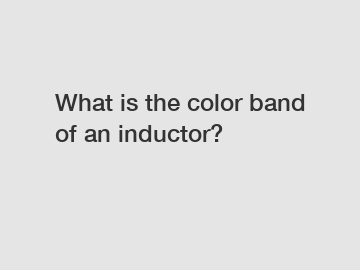What is the color band of an inductor?
Welcome to the exciting realm of electronic components! Amidst the world of circuits and semiconductors lies a humble yet crucial component - the inductor. Often underrated, this compact coil plays a vital role in various electronic devices and circuitry. Today, we unravel the mystery behind the color band found on an inductor, and explore its significance and usage in the electronics domain.
Understanding the Basics.
Before diving into the color band intricacies, let's quickly go over the fundamental role of an inductor. Simply put, an inductor opposes changes in current flow in a circuit, storing energy in its magnetic field. With this in mind, one can see the immense value an inductor holds.

The Importance of Color Coding.
Inductors, like many other electronic components, are color-coded for identification and sorting purposes. The color band, often found on one end of the inductor, provides valuable information about its electrical properties. By discerning the code, engineers and technicians can easily select the right inductor for a specific application.
Using the Color Band as a Guide.
The color band on an inductor holds more information than meets the eye. Typically, there are four bands, each representing a specific parameter:
1. First Band (First significant digit):
This band represents the first digit of the inductor's value. It helps determine the overall magnitude of the inductance. Its significance lies in establishing the baseline value for calculations and circuit design.
2. Second Band (Second significant digit):
Similarly, the second band signifies the second digit of the inductor's value. Together with the first digit, these two bands form a crucial part of the inductance value, ensuring higher precision.
3. Third Band (Multiplier):
The third band provides a multiplier that helps establish the inductor's value range accurately. It denotes the factor by which the preceding digits should be multiplied to determine the actual inductance value. This band plays a critical role in determining the overall behavior of the inductor in a circuit.
4. Fourth Band (Tolerance):
Finally, the fourth band represents the tolerance level, indicating the permissible range within which the inductor's actual value may deviate from the ideal value. It ensures precision and minimizes errors in various applications.
Cracking the Color Code.
Now that we have a basic understanding of the color bands, let's decipher a quick example. Suppose we encounter an inductor with the colors brown, black, red, and silver. Utilizing our knowledge of the color code, we can analyze it as follows:
- The first band (brown) represents the digit '1'.
- The second band (black) corresponds to the digit '0'.
- The third band (red) denotes the multiplier '100'.
- The fourth band (silver) indicates a tolerance level of ±10%.
Combining these values, we can determine that the inductor value is 10x100 ±10%. Thus, we have a 1000μH (microhenry) inductor with a tolerance range of ±10%.
Conclusion.
There you have it - a comprehensive exploration into the significance of the color band on an inductor. By decoding the color pattern, we can efficiently select and utilize inductors in our electronic circuits. The color code provides valuable information about the inductor's value, magnitude, precision, and tolerance, ensuring optimal functionality.
Next time you come across an inductor with those little colored bands, remember that they hold a wealth of information. Embrace the power of color coding, and unlock the myriad possibilities for electronic design, innovation, and functionality!
So, let's appreciate the nuances of this seemingly simple yet incredibly important element in the world of electronics - the color band of an inductor!
Are you interested in learning more about all types of resistors, thick film chip resistors, chip resistor manufacturer? Contact us today to secure an expert consultation!
364
0
0


Comments
All Comments (0)